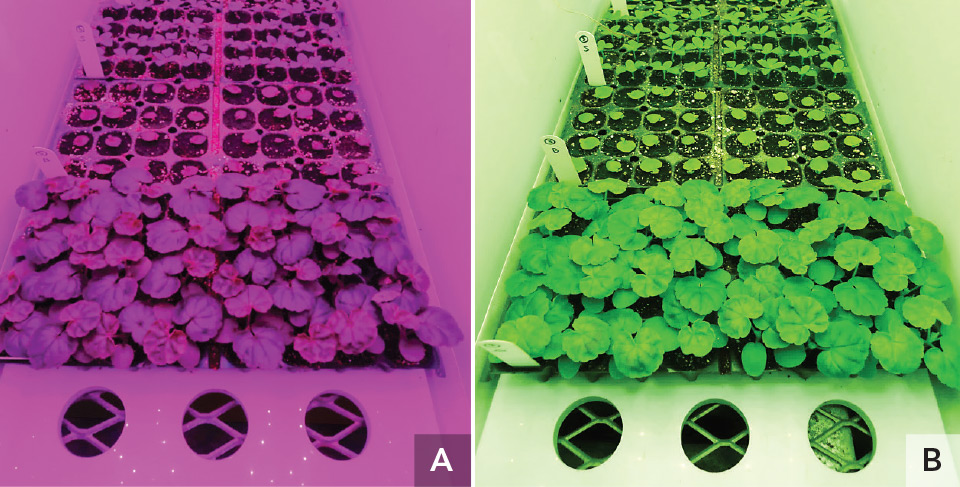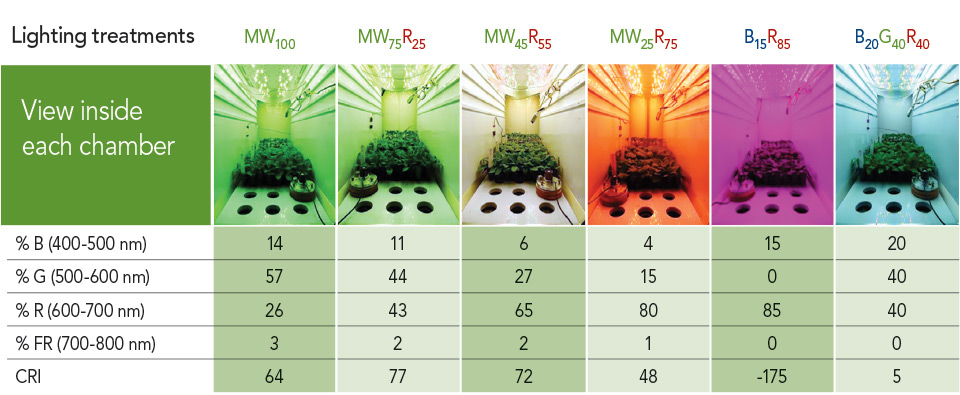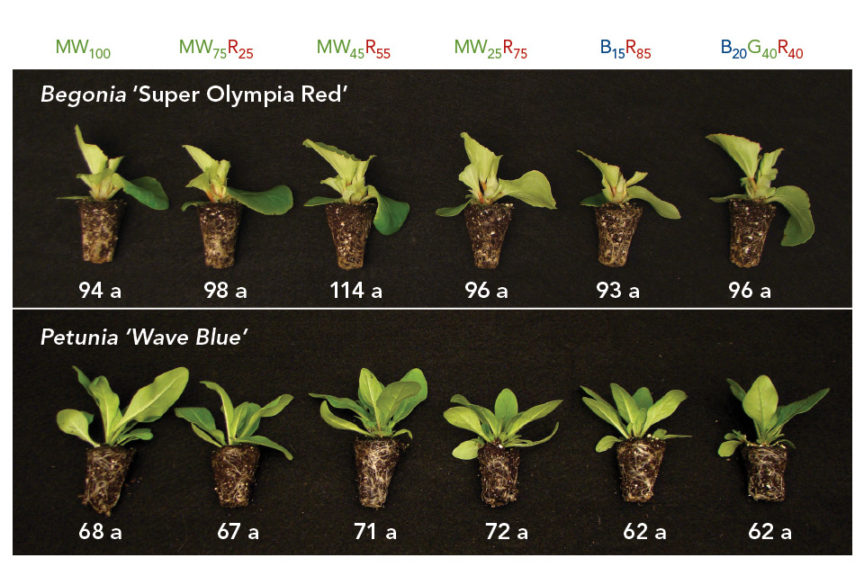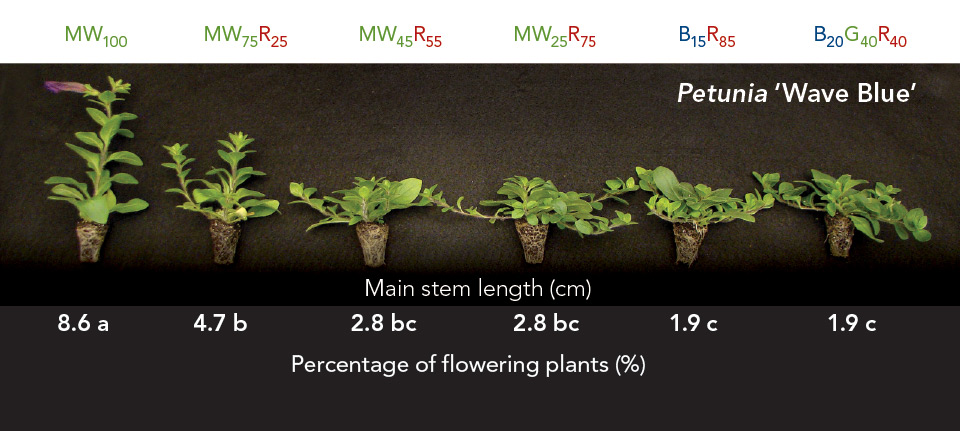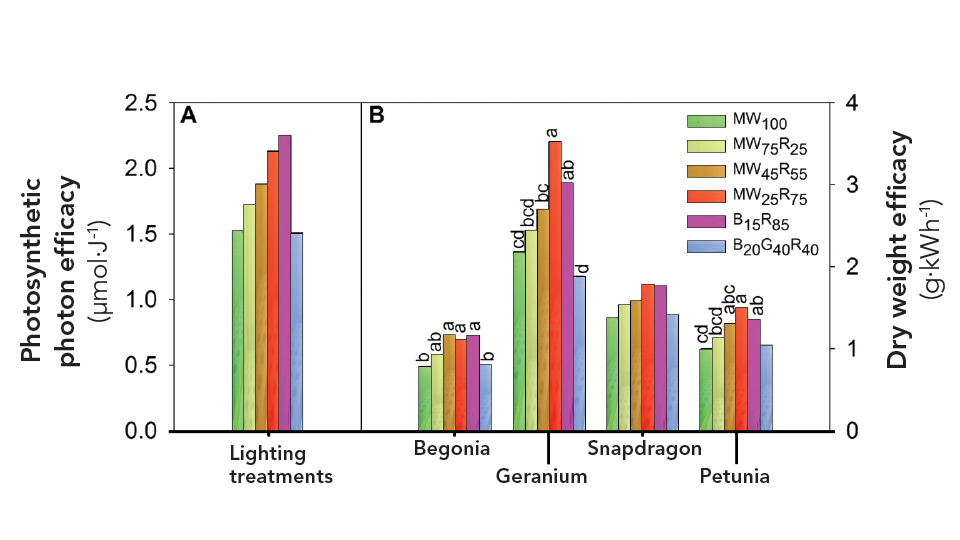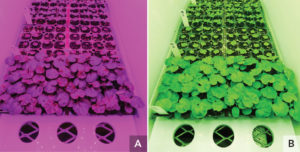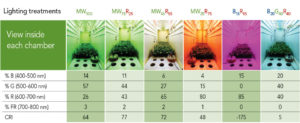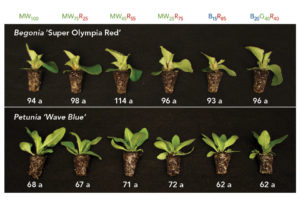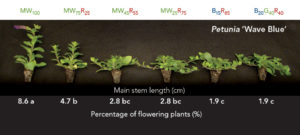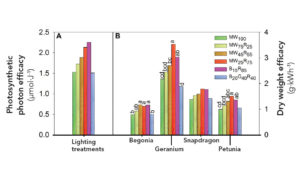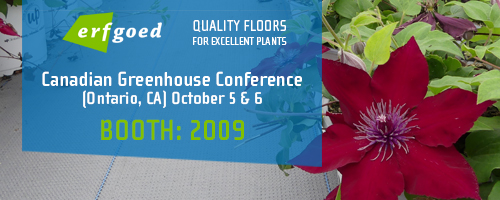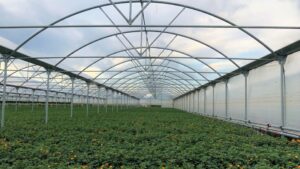Growing Ornamental Seedlings Under White LEDs
Plant growth attributes, including plant size, branching, pigmentation, and flowering time, can all be influenced by light quality, which refers to the spectral distribution of radiation. Thus, using LEDs for indoor plant lighting enables full control of the light spectrum to elicit desired plant growth and developmental responses. In the past decade, research groups have examined how different LED wavebands and their combinations regulate plant growth, especially on lettuce.
Red (600 to 700 nm) light efficiently drives photosynthesis on an instantaneous basis. Under red light alone, many crops are elongated, but the addition of blue (400 to 500 nm) light can produce crops with a more typical growth habit. In addition, blue and red LEDs are efficient at converting electrical energy into light that plants use to drive photosynthesis for growth.
However, horticultural lamps with blue+red LEDs create a purplish light, which makes it difficult to identify discoloration associated with plant nutritional deficiencies, diseases, and physiological disorders (Figure 1). The purplish color can also create an unpleasant working environment. Color rendering index (CRI) is a common metric used for human applications to measure the ability of a light source to reveal the colors of objects. The highest CRI value is 100, which is under sunlight or an incandescent lamp. Fluorescent lamps have CRI values between 50 and 98 depending on the lamp type, while the value for high-pressure sodium lamps is 24. The lower the CRI value, the poorer the color-rendering ability. For human lighting, a recommended CRI value is 70 or higher. Blue+red LED fixtures have a negative CRI, indicating their low accuracy for color rendering.
There are two ways to increase the CRI of blue+red LED mixtures. One is adding green (500 to 600 nm) light to blue+red light using green LEDs. Another is replacing blue LEDs with white LEDs. White LEDs are created by adding a phosphor-based coating to blue LEDs, which converts much of the blue light to green and red light, and to some extent, far-red (700 to 800 nm) light.
However, green LEDs are relatively inefficient based on converting electrical energy into photosynthetic light and thus, using white LEDs is more practical.
Ideally, the spectrum of sole-source LED lighting elicits the desired growth and flowering characteristics desired in a crop, has a high energy efficacy, and has a high CRI value to enhance visual quality. We evaluated the different shades of white light compared to a typical blue+red spectrum in terms of their effect on human vision, energy efficacy, and plant growth attributes. We postulated that, compared to a typical blue+red mixture, using white LEDs or a mixture of white+red LEDs would have similar impacts on growth attributes while increasing human vision, and without an excessive decrease in energy efficacy.
Experimental Protocol
Lighting treatments. We tested six sole-source LED lighting treatments to determine the impacts of different shades of white light compared to a typical blue+red light (Figure 2). The blue+red LEDs provided 15% blue light and 85% red light (B15R85) based on the unit of µmol∙m−2∙s−1. Different shades of white light were delivered by 100% mint-white LEDs (MW100), or three mixtures of mint-white and -red LEDs: MW75R25, MW45R55, and MW25R75. The sixth treatment was 20% blue, 40% green, and 40% red (B20G40R40). The peak wavelengths for the blue, green, mint-white, and red LEDs were 447 nm, 531 nm, 558 nm, and 660 nm, respectively.
For all six of the lighting treatments, the photosynthetic photon flux density (400 to 700 nm) and photoperiod were identically 160 µmol∙m−2∙s−1 and 18 hours, respectively, to establish a daily light integral of 10 mol∙m−2∙d−1. This light integral is a minimum recommended value for producing high quality young plants. The mint-white LEDs used in this study emitted 14% blue, 57% green, 26% red, and 3% of far-red light.
Plant materials and growing conditions. Seeds of Begonia ‘Olympia Red,’ Geranium ‘Deep Rose,’ Petunia ‘Wave Blue,’ and Antirrhinum ‘Liberty Classic Yellow’ were sown in 128-cell plug trays by Raker-Roberta’s Young Plants and received at Michigan State University (MSU) about one week later. When the first true leaves emerged, the seedlings were thinned to one plant per cell. They were then grown under the six LED lighting treatments in a refrigerated growth chamber at a constant 68°F. Approximately three to five weeks after growing under the LEDs, when the seedlings were ready for transplant, growth attributes of seedlings were evaluated in terms of their fresh and dry weight of shoots and roots, seedling height, leaf number, and leaf area.
Evaluation of CRI and Energy Efficacy
The CRI value for each light treatment was determined using ColorCalculator software from OSRAM. The energy efficacy of the lighting treatments was calculated using two parameters: the photosynthetic photon efficacy (which describes the efficacy at converting electric energy into photosynthetic photons) and dry weight efficacy (which indicates the efficacy at converting electric energy into plant dry mass). The photosynthetic photon efficacy for each sole-source LED lighting treatment was estimated by multiplying the photosynthetic photon efficacy of each LED type and the percentage of light delivered by each LED type. The dry weight efficacy for each light treatment was calculated for each plant species by dividing the dry weight gain per electric energy consumption.
The experiment was performed twice in time. Effects of lighting treatments were analyzed with SAS software that provided pairwise comparisons between treatments using Tukey’s honestly significant test at P ≤ 0.05. This allows us to determine if differences between treatments are statistically meaningful.
Research Results
CRI. The CRI values of the five white light treatments were much higher than the B15R85 spectrum, ranging between 48 and 77 (Figure 2). While MW LEDs had a higher CRI value (64) than B20G40R40 LEDs (56), partially substituting MW with R LEDs by 25% or 55% further increased the CRI to 77 or 72, respectively.
Plant growth. In general, at the end of the plug stage, seedling growth characteristics (including seedling height, total leaf area, and fresh and dry weight) of all four species were similar among the different shades of white light and B+R LEDs (Figure 3, page 24). However, as petunia seedlings were grown longer (after the transplant stage) under the lighting treatments, the primary stem elongated and initiated flower buds earlier under MW100 and MW75R25 than the B15R85 treatment (Figure 4, page 24). This early flowering of petunia was not expected.
Energy efficacy. In this study, B15R85 had the highest photosynthetic photon efficacy value of 2.25 µmol∙J–1, while the MW100 and B20G40R40 treatments had around 33% lower values (Figure 5). However, as more of the MW LEDs were substituted with R LEDs, the photosynthetic photon efficacy of the mixture of MW+R LEDs increased very close to that of the B+R LEDs. In addition, growth of seedlings under the B+R LEDs had a similar dry weight efficacy as under mixtures of MW+R LEDs in all four species. This indicates that the mixture of MW+R LEDs can promote growth as efficiently as a typical B+R mixture.
Conclusions
LED arrays manufactured for plant applications typically only include blue+red light, and relatively few studies have investigated the pros and cons of using white LEDs for plant growth applications. This study shows that at least some white light in an LED fixture can produce young plants with similar growth attributes as a blue+red fixture and improve human vision. White light created by only mint-white LEDs or a mixture of blue, green, and red LEDs were less efficient at producing plant dry mass compared to the blue+red light. However, pinkish-white light created by mixing mint-white and red LEDs produced plant mass as efficiently as a typical blue+red mixture.
The authors thank OSRAM, the USDA-ARS Floriculture and Nursery Research Initiative, MSU’s Project GREEEN, and companies supportive of MSU floriculture research for their support. They also thank Raker-Roberta’s for donation of plant material and Nate DuRussel for technical assistance.





